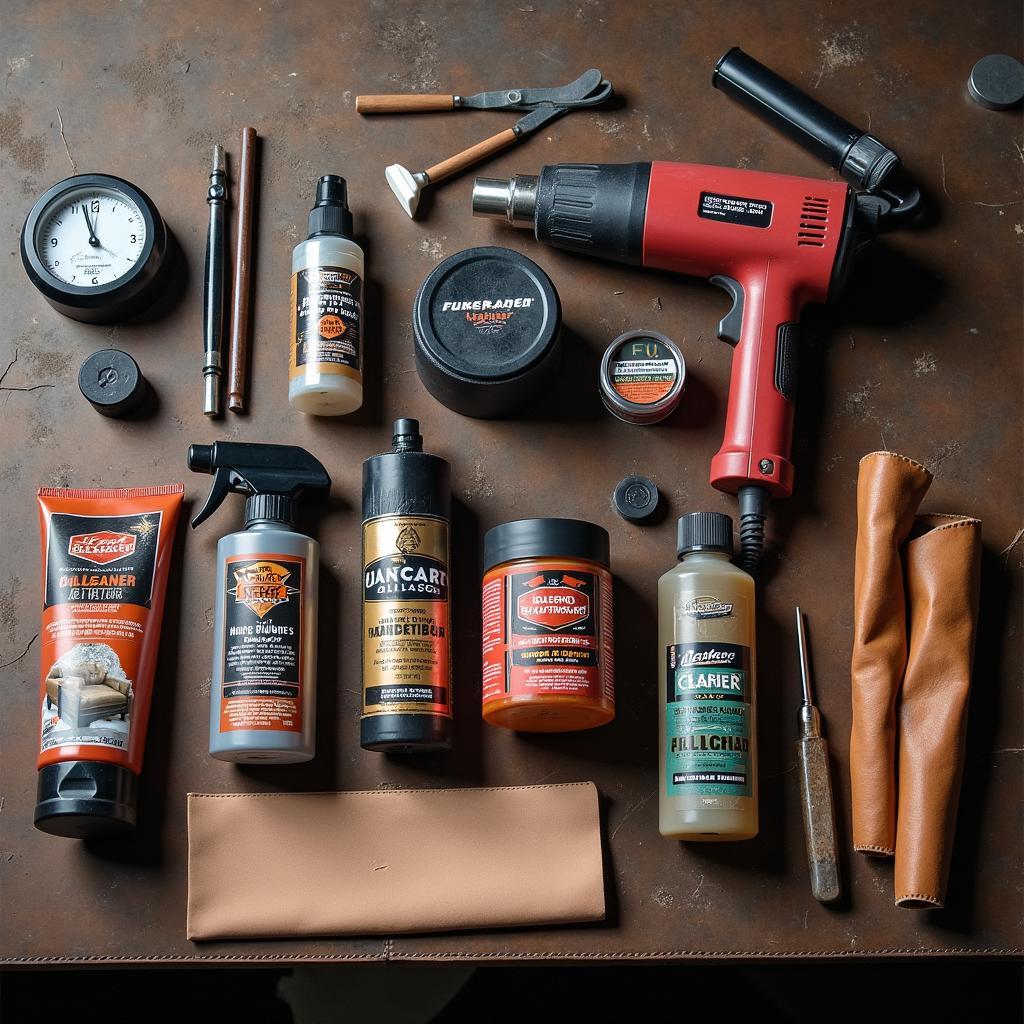Cracked leather seats are a common problem for Ford Escape owners, but luckily, repairing them is possible without breaking the bank. Whether you’re dealing with minor cracks or more severe damage, this guide will equip you with the knowledge and steps to restore your Ford Escape’s leather seats to their former glory.
Before diving into the repair process, it’s essential to gather the necessary tools and materials. Having everything on hand will streamline the process and prevent unnecessary interruptions.
Gathering Your Ford Escape Leather Seat Repair Toolkit
Here’s a checklist of what you’ll need:
- Leather cleaner and conditioner: Opt for high-quality products specifically designed for automotive leather.
- Leather filler: Choose a filler that matches the color of your Ford Escape’s seats.
- Applicator tools: Spatulas, sponges, and microfiber cloths are essential for even application and removal of cleaning and repair products.
- Heat gun or hairdryer: Heat helps the leather filler cure properly and blend seamlessly.
- Leather dye (optional): If the cracks are deep or the color has faded significantly, leather dye can help restore a uniform appearance.
- Fine-grit sandpaper: Used for smoothing out the filler and achieving a professional finish.
- Masking tape and paper: Protect surrounding areas from accidental product contact.
- Gloves and safety glasses: Ensure your safety during the repair process.
Prepping Your Ford Escape’s Leather Seats for Repair
Proper preparation is crucial for a successful repair. Begin by thoroughly cleaning the affected area with a dedicated leather cleaner. Use a soft-bristled brush to gently scrub away dirt, grime, and debris from the cracks and crevices.
Pro Tip from Chris Miller, Senior Automotive Technician at CarDiagTech Workshop: “Before applying any repair products, ensure the leather is completely dry. Moisture trapped beneath the filler can lead to adhesion problems and compromise the repair’s durability.”
Next, use masking tape and paper to protect the surrounding areas of the seat that you don’t want to get any cleaner or filler on.
Repairing the Cracks in Your Ford Escape’s Leather Seats
- Apply the leather filler: Using a small spatula or putty knife, carefully apply the leather filler into the cracks.
- Remove excess filler: Use the spatula to scrape away any excess filler, ensuring the surface is as level as possible.
- Apply heat: Using a heat gun or hairdryer on a low setting, gently apply heat to the filler. This will help it cure faster and create a stronger bond with the leather.
- Sand and smooth: Once the filler is dry, use fine-grit sandpaper to smooth out any rough edges and create a seamless transition between the repaired area and the surrounding leather.
- Clean the area: Use a damp microfiber cloth to wipe away any dust or residue from sanding.
Restoring Your Ford Escape’s Leather Seats’ Appearance
If the cracks were deep or the leather has faded, applying a leather dye can help restore a uniform appearance.
- Choose the right dye: Select a leather dye that closely matches the color of your Ford Escape’s seats. Test the dye on a hidden area first to ensure color accuracy.
- Apply the dye: Using a clean sponge or applicator pad, apply the leather dye evenly to the repaired area, blending it outward for a seamless look.
- Allow to dry: Let the dye dry completely before touching or sitting on the seats.
Conclusion
Repairing cracks in your Ford Escape’s leather seats is a manageable DIY project that can save you money and enhance the overall look of your vehicle’s interior. With patience, attention to detail, and the right tools and techniques, you can achieve professional-looking results. Remember to always prioritize safety by wearing appropriate protective gear and working in a well-ventilated area.
FAQs
Q: Can I use regular super glue to repair cracks in my Ford Escape’s leather seats?
A: No, using super glue or other adhesives not specifically designed for leather can cause further damage and create a stiff, unsightly finish.
Q: How often should I condition my Ford Escape’s leather seats?
A: It’s generally recommended to condition leather seats every three months or as needed, depending on usage and exposure to sunlight and heat.
Q: Can I prevent cracks from forming in my Ford Escape’s leather seats?
A: Regularly cleaning and conditioning your leather seats, parking your car in the shade, and using a sunshade can help prevent premature cracking and fading.
Need further assistance with your Ford Escape’s leather seat repair? Don’t hesitate to reach out to our expert team. Contact us via WhatsApp at +1(641)206-8880 or email us at [email protected]. We’re available 24/7 to answer your questions and provide guidance. For more helpful car repair tips and information, browse our extensive collection of articles on CarRepairOnline.



